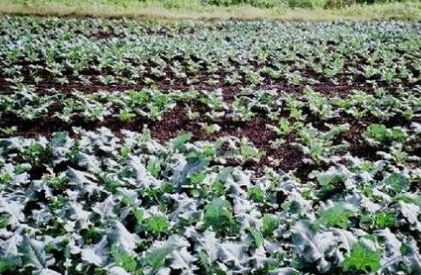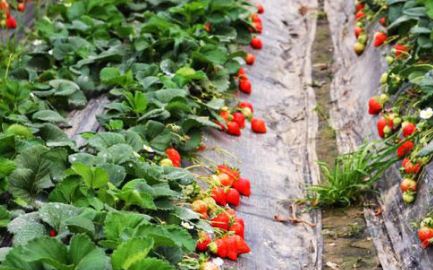Detailed explanation of planting techniques and processing methods of cauliflower
Cauliflower is a kind of flower rare vegetable with high nutritional value and a variety of health care functions, which is liked by many consumers. Its edible part-flower bud has high nutritional value, so it is called "green gold" and "omnipotent nutrition bank". The planting techniques and processing methods of cauliflower are explained in detail as follows:

I. planting techniques of cauliflower
1. Site selection: cauliflower likes warmth and strong adaptability, but the aboveground withered in case of frost; developed root system, strong drought tolerance, good growth in hillside land; lax soil requirements, sand, clay, Pingchuan, mountainous areas can be planted. But red and yellow soil is the best.
2. Deep ploughing and soil preparation: cauliflower is a perennial crop. When ploughing the land, we should pay attention to deep ploughing. Deep ploughing is beneficial to root growth. The depth of ploughing is 20-30cm. In order to facilitate the daily management in the future, the width of the border should be 1-1.5m, and the length of the border should be unlimited, based on the principle of convenience.
3. Growth stage: cauliflower can be divided into seven growth stages: germination from February to mid-March, leaf expansion from mid-March to late May, bolting from late May to mid-June, bud and flowering from mid-June to early July, postharvest withered leaves from early July to early August, autumn leaf expansion from early August to early autumn frost, and dormancy from frost to January the following year.
4. timely transplanting and reasonable close planting: from the end of flower bud harvest to next year's spring seedling, it is best to transplant separately after flower bud harvest, winter seedlings can occur in the same year, new roots can be produced, nutrients can be accumulated, and bolting can be put into production the next year. 16000 holes per mu are planted in rice fields and vegetable gardens with high soil fertility. 2000 holes per mu are planted in sloping land and poor ridge soil. It is better to alternate wide and narrow rows in the way of planting. After transplanting, the roots were watered in time, and covered with plant ash. After survival, 100-200 kg of human feces and urine per mu were used as root fertilizer.
5. Scientific fertilization and watering: rational drainage and irrigation is rainy in spring. We should do a good job in clearing ditches and drainage of cauliflower in time to prevent waterlogging. In the high temperature and drought season from July to August, we should draw water in time to resist drought, keep the soil moist, prolong the harvest period, and increase yield. Water diversion and drought resistance should be carried out sooner or later, so as to achieve urgent irrigation and drainage, not flood irrigation. Cauliflower is very fond of and tolerant to fertilizer, especially for nitrogen, phosphorus and potassium. Fertilization should be carried out in spring seedling germination stage, flowering stage and winter seedling development stage. Spraying Huazhuangtiling at the beginning of bolting can enhance the drought and disease resistance of the plant, prolong the leaf function, promote the stout buds, reduce the shedding of young buds and increase the yield.
6. Harvest: the most suitable time for harvest is bud bud, that is, when the bud is full and not open, the middle color is golden, both ends are green, the top mouth is black, and the sharp mouth seems to be open. The time requirement for picking cauliflower is very strict, too early is not good, too early is green buds, low sugar content, light weight and poor color of fresh buds, resulting in poor color and low yield; picking buds too late, the buds are too mature and loose buds appear, and the juice is easy to flow out, the product quality is poor, and it is difficult to preserve. The harvest season is generally from June to the end of August. The suitable harvest time is that the flower bud is just 1-2 hours before the split mouth, when the yield of cauliflower is high and the quality is good. The best time to pick is from 13:00 to 14:00. The buds picked should be steamed in time to prevent the grin from blooming.
2. Processing methods of cauliflower
After the flower buds of cauliflower are harvested, they should be steamed and processed in time and should not be placed for too long, otherwise the flower buds and pine moss will blossom and affect the quality because of the strong vitality of flower bud cells.
The simplest method of processing cauliflower is single pot and single sieve steaming, which is suitable for families with small cultivation area, but with high fuel consumption and high labor intensity. The steaming process is as follows:
Place an iron pot on an ordinary firewood stove or coal stove, keep clean water 1/3 deep in the pot, and place a wooden cross 4cm above the surface of the water, on which a round bamboo sieve with a sieve edge 8cm high is connected with the iron pot. The fresh buds are placed in the bamboo screen, and the center is braised and piled into a concave shape, which should not be pressed, otherwise the steam is uneven and affects the steaming quality.
First boil the water in the pot with high fire, then put the end of the bamboo sieve on the cross wooden frame, cover it with an arch pot cover, and then burn a small fire for 8 minutes for 10 minutes, until steam emerges around the pot lid, open the pot cover and observe, such as the bud volume naturally sinks 1/3, from yellowish green to light yellow, when the bud becomes soft, it should be taken out immediately, cool for 1 hour for 2 hours, and then dry in the sun. If you can't dry in the sun on a rainy day, you should dry it with a fine fire to prevent mildew and spoilage. If sun-dried cauliflower is not sold immediately, it should be sealed and stored in plastic bags to prevent damp deterioration.
Time: 2019-03-12 Click:
- Prev

How much is the broccoli per jin? What are the key points of planting techniques?
Broccoli, also known as blue broccoli, Italian kale, green cauliflower, tender cauliflower and so on, is a kind of natural food with high nutritional value. We can always find broccoli on the diet of healthy diet, so there are many farmers who grow broccoli.
- Next

Introduction of planting time and Technical points of Strawberry in greenhouse
Strawberry has high nutritional value, contains a variety of nutrients and has health care effect. now it is planted and developed in greenhouse because strawberry in greenhouse has the advantages of easy cultivation, convenient management, low production cost, high yield and good profit. it is suitable for the adjustment of farmland structure and the development of benefit agriculture.
Related
- Fuxing push coffee new agricultural production and marketing class: lack of small-scale processing plants
- Jujube rice field leisure farm deep ploughing Yilan for five years to create a space for organic food and play
- Nongyu Farm-A trial of organic papaya for brave women with advanced technology
- Four points for attention in the prevention and control of diseases and insect pests of edible fungi
- How to add nutrient solution to Edible Fungi
- Is there any good way to control edible fungus mites?
- Open Inoculation Technology of Edible Fungi
- Is there any clever way to use fertilizer for edible fungus in winter?
- What agents are used to kill the pathogens of edible fungi in the mushroom shed?
- Rapid drying of Edible Fungi

